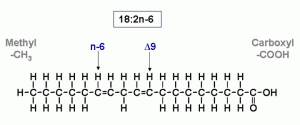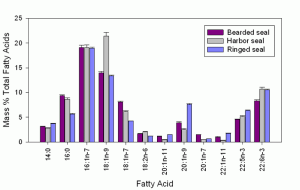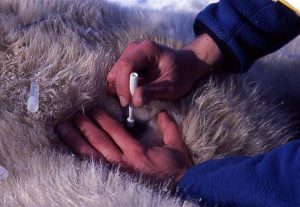Fatty Acid Analysis
Credit: Ian Stirling
Fatty acid signature analysis is a technique used to examine the feeding habits of free-ranging polar bears. It is based on the knowledge that chemical components of food are incorporated, largely unaltered, into a polar bear’s tissues. By looking at the fatty acid composition of a polar bear’s fat, and comparing it to its potential prey, we can make some inferences about what that bear has eaten.
Fatty Acid Structure and Nomenclature

Anatomy of a fatty acid
Fatty acid analysis uses the components of dietary fat as an indicator of past diet. Animal fats (which are also called lipids) are primarily in the form of triacylglycerols: three fatty acid molecules attached to a glycerol backbone. Each fatty acid is made up of a long hydrocarbon chain that contains a variable number of double bonds. The physical characteristics of the fatty acid (e.g., length of the carbon chain, number of double bonds) determine its biochemical properties (e.g., solubility, melting point) and each fatty acid is named according to its structure. For instance, the lower right figure illustrates the structure of linoleic acid, which is also referred to as 18:2n-6. This nomenclature reflects the fact that there are 18 carbons and 2 double bonds in the hydrocarbon chain. The first double bond is in the “n-6” position, which is the sixth carbon from the methyl end of the chain. In most fatty acids, double bonds are separated by a single methylene group (– CH2 –) so the position of all double bonds can be inferred from this shorthand nomenclature. For unusual non-methylene-interrupted fatty acids (see below) the positions of each double bond must be given. These positions are usually expressed relative to the carboxyl end of the molecule (e.g., 22:2∆7,15 has double bonds at the ∆7 and ∆15 positions).
Fatty Acid "Signatures"

Fatty acid signatures. Credit: Thiemann et al. 2008
Researchers can often identify more than 70 different fatty acids in the fat stores of marine organisms like polar bears. Most of these compounds will be present in all of the available foods so we may not be able to determine where any individual fatty acid originated in the diet. However, prey species usually differ in their relative proportions of various fatty acids. This overall profile across several fatty acids is termed a fatty acid signature.
Because fatty acid stores are strongly influenced by diet, differences in fatty acid signatures among polar bears reflect differences in foraging habits. A variety of multivariate statistical tools can be used to determine if groups of bears (e.g., age or sex classes) have different fatty acid signatures. In addition, Iverson et al. (2004) developed a multivariate statistical model that quantitatively estimates the diet composition of individual predators. The model works by identifying the proportional combination of different prey types that comes closest to matching the observed predator signature.
The Importance of Calibration
Polar bears, like other mammalian carnivores, also synthesize their own fatty acids in addition to obtaining them through the diet. Further, some ingested fatty acids will be preferentially utilized for energy whereas other fatty acids will be directly stored without modification. The end result of these metabolic processes is that the fatty acid signature of a polar bear will never exactly match its dietary composition. To account for this, calibration coefficients have been developed for polar bears by using captive mink that were fed a controlled diet of marine fish and oil (Mustela vison; Thiemann et al. 2008). Calibration coefficients are determined by comparing the fatty acid profile of the consumer with that of its controlled diet. Differences in these two profiles are the result of specific metabolic processes and correction factors can be applied to the fatty acid data collected from free-ranging polar bears. New research has found that calibration coefficients can also be estimated from prey and predator fatty acid data alone, without the need for controlled feeding experiments (Bromaghin et al. 2017).
Studying diets using fatty acids

Getting fatty acid samples from a polar bear. Credit: Dennis Andriashek
The fatty acid profile of an individual polar bear can be readily determined from a small tissue biopsy taken through the skin of an immobilized bear. This technique has been used to generate quantitative estimates of polar bear diets across the Canadian Arctic (Iverson et al. 2006, Thiemann et al. 2008, Galicia et al. 2015).
The QFASA approach models the fatty acid signature of a predator as a combination of the signatures of its potential prey. Diet is thus estimated as the proportional combination of prey that minimizes the distance between the modelled and observed predator signatures, after applying calibration coefficients. Multiple refinements have been made to the QFASA approach in recent years that allow researchers to improve the accuracy and precision of QFASA-derived estimates (e.g., Bromaghin et al. 2015, 2016, 2017). The package qfasar allows users to run QFASA, and multiple diagnostics, in the R software environment.
Future applications
Fatty acid signature analysis will be a valuable tool for monitoring future changes in polar bear foraging. With the rapid environmental changes that have occurred in the Arctic and are predicted to continue, fatty acid analysis may allow researchers to identify shifts in food web structure and functioning that may otherwise be difficult to detect.
Further Reading
- • Bromaghin JF, Rode KD, Budge SM, and Thiemann GW. 2015. Distance measures and optimization spaces in quantitative fatty acid signature analysis. Ecology and Evolution 5: 1249-1262.
- Bromaghin JF, Budge SM, Thiemann GW, and Rode KD. 2016. Assessing the robustness of quantitative fatty acid signature analysis to assumption violations. Methods in Ecology and Evolution 7: 51-59.
- Bromaghin JF, Budge SM, Thiemann GW, and Rode KD. 2017. Simultaneous estimation of diet composition and calibration coefficients with fatty acid signature data. Ecology and Evolution 7: 6103-6113.
- Galicia MP, Thiemann GW, Dyck MG, and Ferguson SH. 2015. Characterization of polar bear (Ursus maritimus) diets in the Canadian High Arctic. Polar Biology 38: 1983-1992.
- Iverson SJ, Field C, Bowen WD, and Blanchard W. 2004. Quantitative fatty acid signature analysis: a new method of estimating predator diets. Ecological Monographs 74: 211-235.
- Iverson SJ, Stirling I, and Lang SLC. 2006. Spatial and temporal variation in the diets of polar bears across the Canadian Arctic: indicators of changes in prey populations and environment. Pp. 98-117 in Boyd IL, Wanless S, and Camphuysen CJ (eds). Top Predators in Marine Ecosystems. Cambridge University Press, New York, NY.
- Thiemann GW. 2008. Using fatty acid signatures to study bear foraging: technical considerations and future applications. Ursus 19: 59-72.
- Thiemann GW, Iverson SJ, and Stirling I. 2008. Polar bear diets and arctic marine food webs: insights from fatty acid analysis. Ecological Monographs 78: 591-613.
